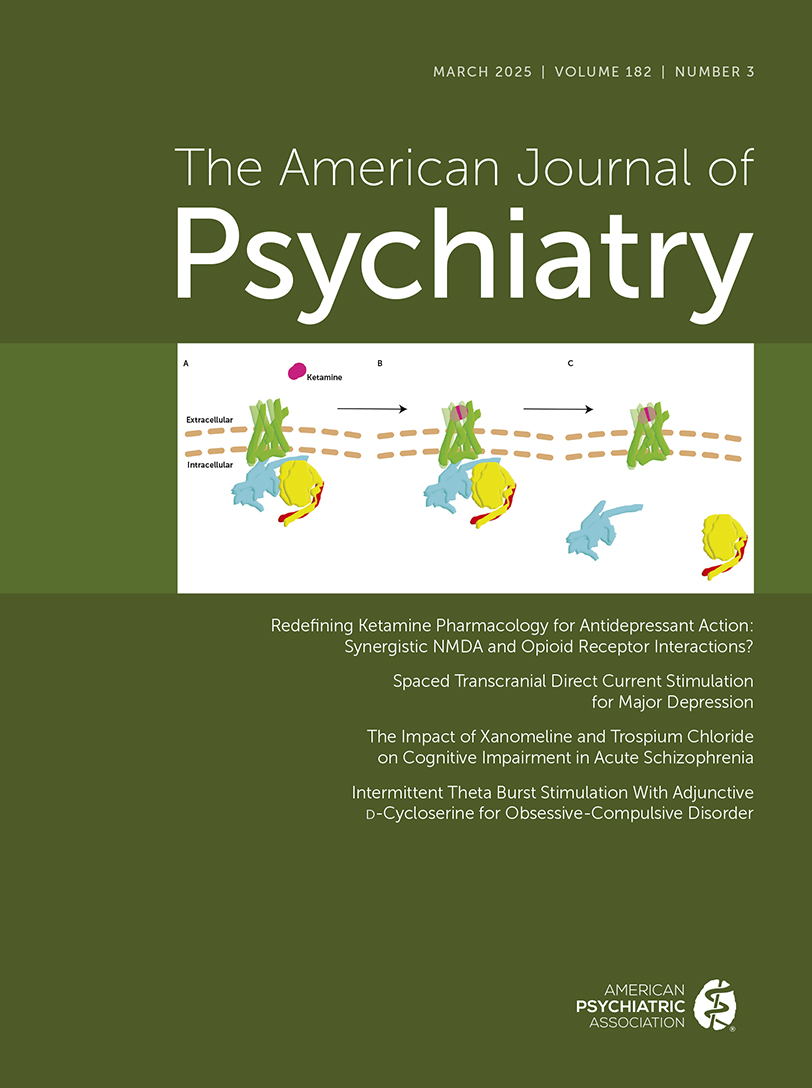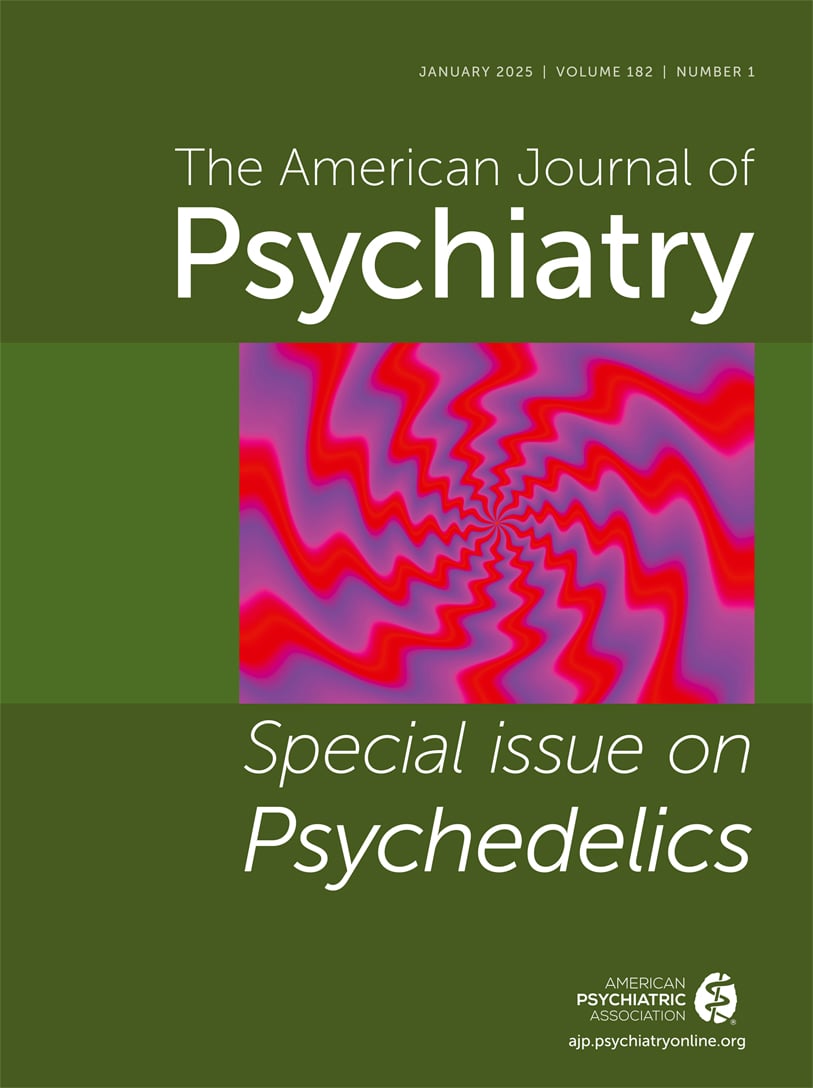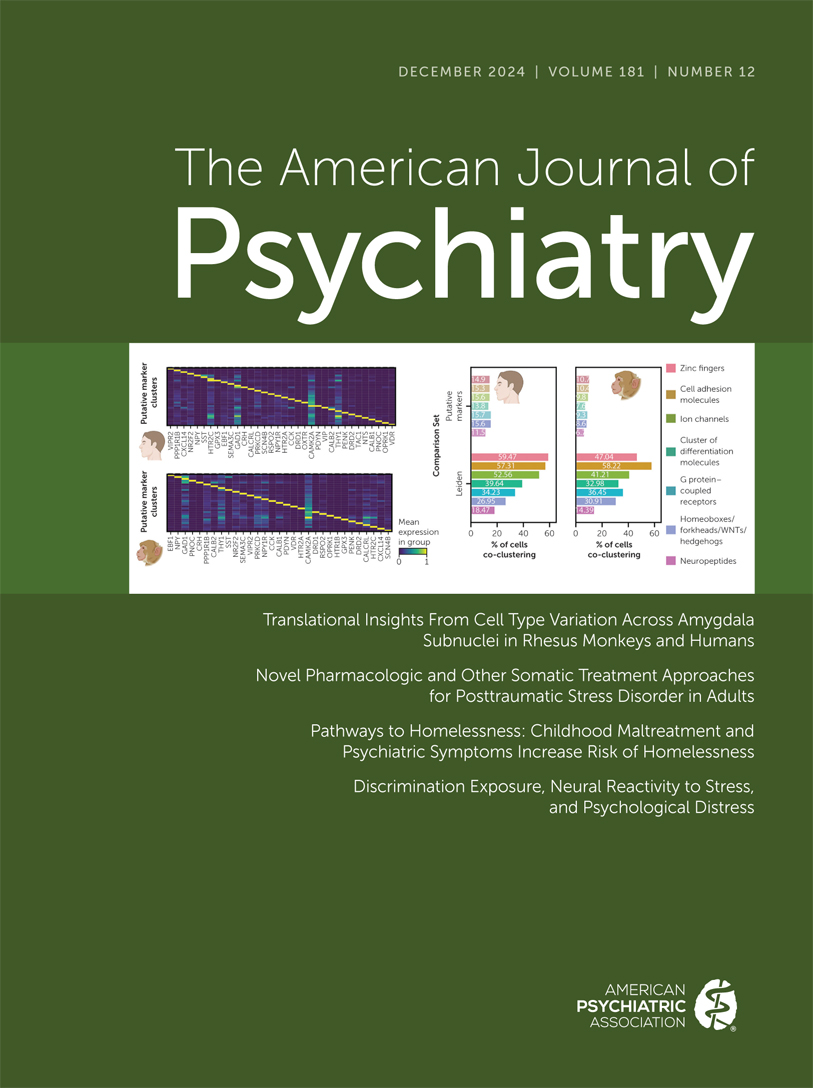American Journal of Psychiatry
- Volume 160
- Number 6
- June 2003
In This Issue
Editorial
Reviews and Overviews
Publication date: 01 June 2003
Pages1028–1040OBJECTIVE: The purpose of this review was to examine the literature assessing the relationship between prenatal exposure to nicotine, alcohol, caffeine, and psychosocial stress during pregnancy to the risk of developing behavioral problems related to ...
https://doi.org/10.1176/appi.ajp.160.6.1028Publication date: 01 June 2003
Pages1041–1052OBJECTIVE: Epidemiological studies indicate that experimentation with addictive drugs and onset of addictive disorders is primarily concentrated in adolescence and young adulthood. The authors describe basic and clinical data supporting adolescent ...
https://doi.org/10.1176/appi.ajp.160.6.1041Images in Neuroscience
Introspections
Clinical Case Conference
Images in Psychiatry
Article
Publication date: 01 June 2003
Pages1061–1070OBJECTIVE: The characteristics of attention deficit hyperactivity disorder (ADHD) include abnormalities in reward responsivity that may interfere with decision making. The study examined reward responsivity in ADHD by comparing the neural correlates of ...
https://doi.org/10.1176/appi.ajp.160.6.1061Publication date: 01 June 2003
Pages1071–1077OBJECTIVE: Nationally representative descriptive data were presented regarding recent trends in the outpatient treatment of attention deficit hyperactivity disorder (ADHD) in children. METHOD: Service use data were analyzed in children ages 3 to 18 years ...
https://doi.org/10.1176/appi.ajp.160.6.1071Publication date: 01 June 2003
Pages1078–1085OBJECTIVE: This longitudinal study had three aims: 1) determine the extent to which boys at high average risk and low average risk for substance use disorder differ on a construct of neurobehavioral disinhibition, 2) evaluate the capacity of ...
https://doi.org/10.1176/appi.ajp.160.6.1078Publication date: 01 June 2003
Pages1086–1092OBJECTIVE: During the Holocaust, extreme trauma was inflicted on children who experienced it. Two questions were central to the current investigation. First, do survivors of the Holocaust still show marks of their traumatic experiences, even after more ...
https://doi.org/10.1176/appi.ajp.160.6.1086Publication date: 01 June 2003
Pages1093–1099OBJECTIVE: This study compared risk factors for suicide and medically serious nonfatal suicide attempts among youth under 25 years of age. METHOD: Three groups were examined: individuals who committed suicide (N=60), individuals who made serious suicide ...
https://doi.org/10.1176/appi.ajp.160.6.1093Publication date: 01 June 2003
Pages1100–1109OBJECTIVE: NMDA receptor dysfunction has been implicated in the pathophysiology of schizophrenia. The NMDA receptor is a multimeric ligand-gated ion channel, and the obligate NR1 subunit is expressed as one of eight isoforms due to the alternative ...
https://doi.org/10.1176/appi.ajp.160.6.1100Publication date: 01 June 2003
Pages1110–1116OBJECTIVE: Postmortem and in vivo brain imaging studies have identified abnormalities in the thalamus and the pons in both schizophrenia and alcoholism. The authors sought to determine whether patients with both schizophrenia and alcohol dependence would ...
https://doi.org/10.1176/appi.ajp.160.6.1110Publication date: 01 June 2003
Pages1117–1124OBJECTIVE: The efficacy of the branched-chain amino acids in the treatment of tardive dyskinesia in men with psychiatric disorders was tested. METHOD: Public-sector psychiatric patients with long histories of antipsychotic treatment and presumably long-...
https://doi.org/10.1176/appi.ajp.160.6.1117Publication date: 01 June 2003
Pages1125–1132OBJECTIVE: The authors assessed the efficacy and safety of the first long-acting atypical antipsychotic (long-acting injectable risperidone) in patients with schizophrenia. METHOD: In a 12-week, multicenter, double-blind, randomized study, patients ...
https://doi.org/10.1176/appi.ajp.160.6.1125Publication date: 01 June 2003
Pages1133–1138OBJECTIVE: In light of the efficacy of newer antipsychotic agents and the possibility that drug withdrawal may negatively affect subsequent drug response, concern has arisen that the use of placebo in schizophrenia research may be unethical. This study ...
https://doi.org/10.1176/appi.ajp.160.6.1133Publication date: 01 June 2003
Pages1139–1146OBJECTIVE: Study findings indicating that involuntary outpatient commitment can improve treatment outcomes among persons with severe mental illness remain controversial. Opponents of outpatient commitment argue that its coerciveness is unacceptable even ...
https://doi.org/10.1176/appi.ajp.160.6.1139Publication date: 01 June 2003
Pages1147–1156OBJECTIVE: The goal of this study was to determine risk factors for depression among elderly community subjects. METHOD: MEDLINE and PsycINFO were searched for potentially relevant articles published from January 1966 to June 2001 and from January 1967 to ...
https://doi.org/10.1176/appi.ajp.160.6.1147Publication date: 01 June 2003
Pages1157–1162OBJECTIVE: Cognitive impairment is common after stroke and may be caused by poststroke depression. Remission of poststroke major depression after treatment has been associated with improvement in cognitive function. The current study was designed to ...
https://doi.org/10.1176/appi.ajp.160.6.1157Publication date: 01 June 2003
Pages1163–1168OBJECTIVE: Factitious disorder with physical symptoms characterizes patients who strive to appear medically ill and assume the sick role. Clinical suspicion is highest for female health care workers in the fourth decade of life. This study was designed to ...
https://doi.org/10.1176/appi.ajp.160.6.1163Brief Report
Publication date: 01 June 2003
Pages1169–1172OBJECTIVE: This study compared the severity of depression in preschoolers diagnosed by standard versus modified DSM-IV criteria for major depression. METHOD: A group of 145 preschoolers and their caregivers underwent a diagnostic assessment for preschool ...
https://doi.org/10.1176/appi.ajp.160.6.1169Publication date: 01 June 2003
Pages1172–1174OBJECTIVE: The authors examined facial expression recognition in adolescents with mood and anxiety disorders. METHOD: Standard facial emotion identification tests were given to youth with bipolar disorder (N=11) or DSM-IV anxiety disorders (N=10) and a ...
https://doi.org/10.1176/appi.ajp.160.6.1172Publication date: 01 June 2003
Pages1175–1177OBJECTIVE: The authors investigated the efficacy of habit reversal for Tourette’s disorder, which is characterized by multiple motor and vocal tics. METHOD: Thirty-two patients with Tourette’s disorder were randomly assigned to 14 sessions of either habit ...
https://doi.org/10.1176/appi.ajp.160.6.1175Publication date: 01 June 2003
Pages1177–1179OBJECTIVE: In this study, the volume and neuronal number of the pulvinar thalamic nucleus in schizophrenia patients were measured. METHOD: The authors examined medial and lateral pulvinar nuclei bilaterally in 27 patients with schizophrenia and 28 normal ...
https://doi.org/10.1176/appi.ajp.160.6.1177Publication date: 01 June 2003
Pages1180–1183OBJECTIVE: Proton magnetic resonance spectroscopy was used to evaluate gender influences on alcohol-associated changes in brain metabolism. METHOD: Concentrations of N-acetylaspartate, choline-containing compounds, myo-inositol, and creatine plus ...
https://doi.org/10.1176/appi.ajp.160.6.1180Publication date: 01 June 2003
Pages1183–1185OBJECTIVE: An earlier Finnish cohort study suggested that childhood viral CNS infections are associated with a fivefold increased odds of developing schizophrenia in adulthood. The authors sought to replicate this finding. METHOD: From the archives of the ...
https://doi.org/10.1176/appi.ajp.160.6.1183Letter to the Editor
Book Forum: Psychotherapy
Book Forum: Psychopharmacology
Book Forum: Law and Ethics
Book Forum: Textbooks
Past Issues
View Issues Archive
Vol. 182 | No. 3

Vol. 182 | No. 2

Vol. 182 | No. 1
